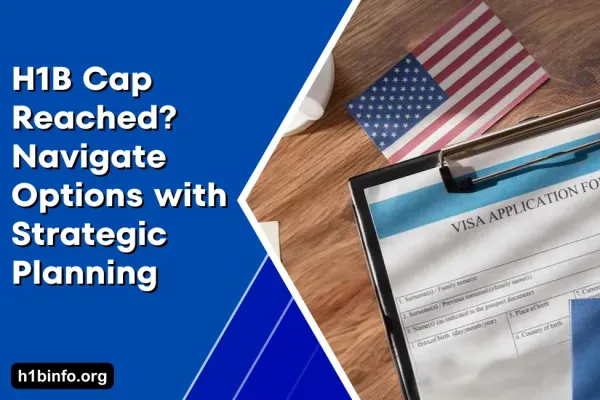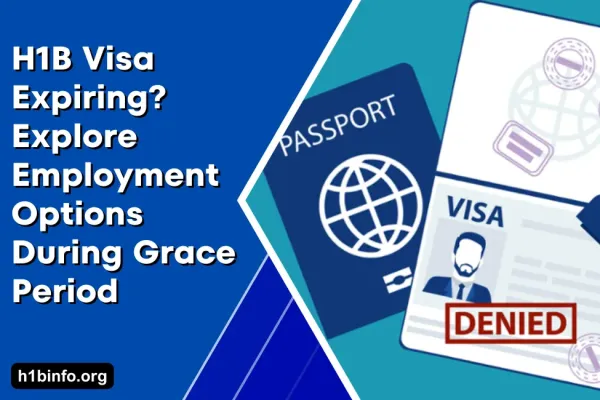In the current situation, only 85,000 H1B visas are available every year. USCIS stops accepting H1B petitions as soon as it gets enough applications to meet the cap for that year. While submitting your application as soon as the quota opens might be a possible immigration strategy to navigate the H1B Cap, it's not always practical because the cap is often reached on the very first day.
Hiring H1B Cap Exempt Candidates, and Students on F-1 OPT
Here are the conditions and actions to take about hiring H1B Cap Exempt Candidates when your H1B cap is reached:
-
Employing H1B Candidates Already in the U.S.
Professionals who are currently on H1B status and are already inside the United States working for another employer can be hired without being subject to the yearly cap.
- When an H1B employee moves from one employer to another, they don't need to wait for the transfer request to be approved before they can begin working for the new employer.
- The candidate can begin working for the new company as soon as the application is submitted to the USCIS
-
Hiring Candidates From Outside the United States Who Were Previously Included in the H1B Cap
Even when the H1B Cap limit has been reached, employers can still submit H1B applications for foreign individuals who are currently located outside the United States, as long as they have held an H1B visa within the past six years and haven't used up their entire six-year quota.
Additionally, if the candidate still possesses a valid H1B visa stamped in their passport, they may be able to travel to the United States right after the H1B application is approved, without needing to request a new H1B visa.
Questions to Consider:
- Has the candidate received H1B approval within the last six years?
- Was the candidate previously counted in the H1B Cap within the last six years?
- Does the candidate have remaining time within the six-year limit to reclaim?
- Does the candidate hold a valid H1B visa stamped in their passport?
- Employing Students Under the F-1 OPT Program
Employers have the option to hire international students in the United States as part of their Optional or Curricular Training Program (F-1 OPT). Typically, foreign students enrolled in Bachelor's and Master's degree programs are allowed one year of full-time off-campus employment during their F1 OPT period.
Furthermore, F-1 students who have completed a qualifying degree in Science, Technology, Engineering, or Mathematics (STEM) are eligible to apply for an additional 17-month STEM extension, extending their OPT period to a total of 27 months.
If the H1B Cap is reached before the employer can file an H1B petition on behalf of these STEM students, they can take advantage of the 17-month STEM extension for post-completion OPT, allowing them to stay and work in the United States until the next round of H1B Cap petitions can be filed.
-
Hiring Candidates From Outside the United States Who Were Previously Included in the H1B Cap
Even when the H1B Cap limit has been reached, employers can still submit H1B applications for foreign individuals who are currently located outside the United States, as long as they have held an H1B visa within the past six years and haven't used up their entire six-year quota.
Additionally, if the candidate still possesses a valid H1B visa stamped in their passport, they may be able to travel to the United States right after the H1B application is approved, without needing to request a new H1B visa.
Questions to Consider:
- Has the candidate received H1B approval within the last six years?
- Was the candidate previously counted in the H1B Cap within the last six years?
- Does the candidate have remaining time within the six-year limit to reclaim?
- Does the candidate hold a valid H1B visa stamped in their passport?
- Employing Students Under the F-1 OPT Program
Employers have the option to hire international students in the United States as part of their Optional or Curricular Training Program (F-1 OPT). Typically, foreign students enrolled in Bachelor's and Master's degree programs are allowed one year of full-time off-campus employment during their F1 OPT period.
Furthermore, F-1 students who have completed a qualifying degree in Science, Technology, Engineering, or Mathematics (STEM) are eligible to apply for an additional 17-month STEM extension, extending their OPT period to a total of 27 months.
-
Other Choices
If the H1B Cap is reached before the employer can file an H1B petition on behalf of these STEM students, they can take advantage of the 17-month STEM extension for post-completion OPT, allowing them to stay and work in the United States until the next round of H1B Cap petitions can be filed.
-
J-1 Visa
The J-1 trainee visa is a good choice for employees who lack experience but want to be in the U.S. to learn about a client's product or their prospective employer's products. Before considering the J-1 visa, employers should check if the two-year home country residency rule applies to their specific situation.
The spouse and unmarried children under 21 of a J-1 visa holder can come to live in the U.S. on J-2 visas. Dependents of a J-1 visa holder may also work in the U.S. if they get special permission from the USCIS and can confirm they don't need employment to support the main J-1 visa holder.
-
B-1 Visa
The B-1 visa category is for cases where a foreign national is needed in the U.S. for project discussions, analysis, or other permissible 'business activities,' as long as they aren't paid any salary or remuneration in the U.S. immigration law strictly prohibits B-1 visa holders from working in the U.S. B-1 holders are also not allowed to start any educational programs.
-
O-1 Visa
The O-1 visa category is for exceptional individuals who are the top experts in their field. It can be used for artists, entertainers, athletes, scientists, researchers, and business professionals. People providing essential support services for O-1 nonimmigrants can apply for O-2 visas to come and work in the U.S.
How Can You Recruit H-1B Candidates Who Are Exempt from the Cap?
Employers who want H-1B visas for potential employees encounter significant challenges. This is because there are only a limited number of H-1B visas available, and the maximum cap for H-1B petitions is often reached within the first few days of filing.
-
Hiring H-1B Candidates Exempt from the Cap - What Are the Qualifications?
While the statutory limit for H-1B visas is currently set at 65,000, employers should be aware that there are various situations where candidates can be exempt from this cap. Understanding these exemptions can help employers hire H-1B candidates even when the cap has been reached.
Three Scenarios for Hiring H-1B Candidates Exempt from the Cap
Not all H-1B petitions are subject to the cap. There are two main categories of H-1B cap-exempt petitions:
- Petitions filed for H-1B candidates who are exempt from the cap.
- Petitions filed by employers who are exempt from the H-1B cap.
The H-1B program allows U.S. employers to hire foreign nationals for "specialty occupations" within the U.S. workforce.
-
Hiring Candidates Already Counted Against the H-1B Cap
Who to Hire:
Employ H-1B candidates who have already been counted against the H-1B cap within the past six years.
Why:
They are not subject to the H-1B cap and won't be counted again.
Regardless of whether the H-1B cap has been met, employers can submit H-1B petitions for amendments, extensions, or changes of employer on behalf of foreign nationals who have been counted against the cap in the last six years.
Even if the H-1B cap has been reached, the U.S. Citizenship and Immigration Services (USCIS) will continue to process petitions too:
Extend the duration of stay for current H-1B workers in the United States.
- Modify the terms of employment for current H-1B workers.
- Permit current H-1B workers to switch employers.
- Allow current H-1B workers to work concurrently in a second H-1B position.
Please Note: When filing an H-1B petition for a change in employer, petitioners should confirm that the foreign national is not transferring from a cap-exempt employer or position. If the beneficiary has not previously been counted toward the cap, they will be subject to H-1B cap restrictions, and employers will not be able to file a transfer petition for them unless the cap is open.
H-1B Job Start for AC21 Candidates
According to the American Competitiveness in the 21st Century Act (AC21), if someone is seeking an H-1B job, they can start working for the new employer as soon as the new employer submits the H-1B application to USCIS. This means that the person doesn't have to wait for USCIS to approve the new H-1B petition before they can begin working for the new employer.
-
Candidates Living Outside the U.S. Who Were Previously Granted H-1B Status
Hiring Eligibility:
People who were previously given H-1B status within the last 6 years and are currently residing in another country.
Reason:
These individuals are not counted in the H-1B quota and can use the remaining part of their six-year H-1B period.
Even if the H-1B quota has been met, employers can still submit H-1B petitions for foreign nationals who are currently outside the U.S., as long as they held H-1B status during the past six years and haven't used up the entire six-year period.
Foreign nationals outside the U.S. who held H-1B visa status during the past six years and haven't used the full six-year duration, and who have spent a complete year outside the U.S. since their last departure from the U.S. in H-1B status, have the choice of utilizing the remaining part of their six-year period or going through the cap process again to potentially receive a new full six-year period if the cap is still open.
-
STEM Students with F-1 OPT
Hiring Eligibility:
International students in F-1 status who have finished a qualifying degree in Science, Technology, Engineering, or Mathematics (STEM) and are in an approved post-completion Optional Practical Training (OPT) period based on a designated STEM degree.
Reason:
They can apply for a 24-month STEM extension of their post-completion OPT, extending their total OPT period to 36 months.
If the H-1B cap has been reached before the employer can file an H-1B petition for these candidates, the students can take advantage of the 24-month STEM extension for their post-completion OPT. This allows them to stay and work in the U.S. until the next H-1B cap season begins.



